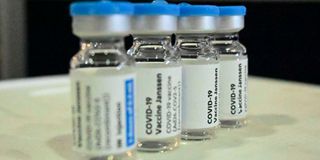Low uptake of Covid-19 vaccines worrying as staff discard doses discard

Johnson & Johnson vaccines sent to North-eastern counties.
What you need to know:
- Covid-19 doses going to waste, especially in the arid and semi-arid areas.
- Insecurity has worsened matters in counties such as Marsabit.
Covid-19 vaccines are going to waste in some parts of Kenya amid very low uptake, the Nation has learnt.
As Kenya races against time to vaccinate at least 10 million people by Christmas, more vaccines are being deployed to the counties. Many doses are, however, going to waste, especially in the arid and semi-arid areas.
Hospitals are reportedly throwing away half-utilised vaccine vials after six hours as there are no takers.
This has prompted the Ministry of Health to explain that Johnson and Johnson's vaccine supplied to arid and semi-arid counties can still be refrigerated at -20 degrees Celsius even after opening the vial.
“We are taking the vaccine in those counties because of many factors, one of them is storage because of the low uptake. The other is that the areas are inaccessible,” explained Dr Willis Akhawale, chairperson of the Covid-19 task force.
Dr Akhawale directed the facilities to keep the doses as long as they are refrigerated.
“Even after opening, if refrigerated, the vaccine can stay for over two years. This is different from other vaccines. For J and J, wastage should not arise,” he said.
Health ministry data show that as of Thursday, the 10 counties with the lowest vaccine uptake included Mandera at 2.3 per cent, Wajir (2.5 per cent), West Pokot 2.6 per cent, Turkana 2.7 per cent, Tana River 2.8 per cent.
Marsabit had 3.1 per cent, Narok 3.2 per cent, Garissa 3.3 per cent, with Bomet and Kilifi at 3.9 per cent and 4.1 per cent respectively
Insecurity has worsened matters in counties such as Marsabit.
Awareness campaign
When the Nation visited Marsabit town around 10 am on Friday last week, the place was deserted and all the shops and hospitals closed. The Nation learnt that a resident had just been shot and no one was willing to go out for the Covid-19 jab.
“This is the situation we have to live with. Everyone is scared because of the daily killings. Which healthcare worker will venture out of their workplace to conduct an awareness campaign or take the vaccine to the people with these killings?” county vaccines logistician Abdu Halaki said.
Mr Halaki said on most occasions, vials were not being fully utilised, as major vaccination centres, including Marsabit County Referral Hospital, are vaccinating only two people in a day.
A vial of Johnson and Johnson, which is what the county has, can vaccinate five people.
“After opening the vial and vaccinating two people, you must ensure it is fully utilised, but with no people to vaccinate, it goes to waste as people are not leaving their houses due to insecurity,” he said.
According to the US Centers for Disease Control and Prevention (CDC), vaccine wastage occurs when vaccine vials are kept for too long outside a given temperature range, among other reasons.
Marsabit has received about 8,740 doses of the AstraZeneca vaccine and 8,100 doses of Johnson and Johnson, and administered 3,295 first doses and 1,723-second doses of AstraZeneca, as well as 3,423 doses of Johnson and Johnson.
"We still have 2,600 doses of Johnson and Johnson and 1,000 AstraZeneca doses in the store awaiting distribution," he said.
"I know we are the last county as far as the uptake of vaccines is concerned, but this is due to challenges such as insecurity and vaccine wastage. We are vaccinating around 150 people per day in the whole county," he said
Even the official warning that unvaccinated people will not access government services does not seem to have any effect on the uptake of the Covid-19 jab in the county.
Fully vaccinated
“Right now, even walking on the streets is dangerous. They come and shoot you and run away. Why would I risk my life because of a vaccine?” wondered one resident, adding that his neighbour had been shot in broad daylight.
“Previously, we would move around telling people to go and get inoculated and at times take the vaccines to them, but it’s now too dangerous,” Mr Halaki said.
Cumulatively, Kenya has administered 7.8 million doses of various vaccines. Out of this, 4.7 million are partially vaccinated and 3.1 million fully vaccinated, which works out to 11 per cent.
The government is working towards vaccinating 27 million people as countries rush against time to vaccinate more of their population to prevent another surge in infection that may be contributed by the new variant, Omicron.
The new variant was first detected in southern Africa and has since triggered alarms globally, with more countries reporting cases.
The variant, with several mutations, has so far been reported in the US, Europe, Israel and China, among other countries.
Several countries have banned or put strong restrictions on travellers from countries in southern Africa where the new variant is said to be widespread.
The WHO classified Omicron as a “variant of concern" but said there was no evidence to support the need for new vaccines specifically designed to tackle the variant with its many mutations.
In East Africa, Uganda has already detected at least seven cases of the new variant amongst travellers who entered the country in late November.
Kenya has not recorded a single case of Omicron.





